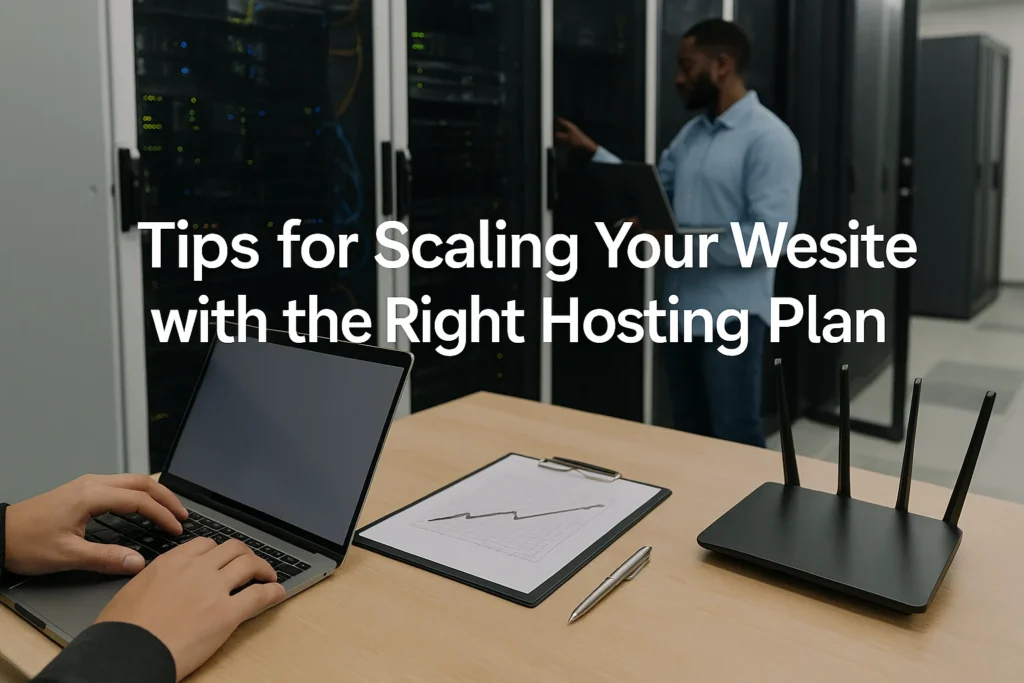In today’s digital economy, your website is more than just an online presence—it is often the central hub for your business, brand, or creative work. Whether you are running an e-commerce store, a content-rich blog, a SaaS platform, or a portfolio, your website must be capable of handling growth without breaking down under pressure.
This is where choosing the right hosting plan becomes critical. Scaling a website is not just about adding more pages or attracting more visitors; it’s about ensuring your hosting infrastructure can accommodate increasing demand while maintaining speed, security, and reliability.
Many websites start small, hosted on affordable shared plans that provide basic resources. However, as traffic grows, you will need more powerful solutions such as Virtual Private Servers (VPS), cloud hosting, or even dedicated servers.
Choosing the wrong hosting plan can result in downtime, slow performance, and missed opportunities. On the other hand, selecting the right hosting solution ensures that your site scales seamlessly with user demands, protects your brand reputation, and supports long-term growth.
In this comprehensive guide, we will explore practical tips for scaling your website with the right hosting plan. We will discuss signs that it’s time to upgrade, the various types of hosting available, best practices for scaling efficiently, and future-proofing strategies to ensure long-term success.
Understanding Website Scaling
Before diving into hosting plans, it’s essential to understand what scaling a website really means. Website scaling refers to adjusting your infrastructure to handle higher traffic volumes and increasing resource demands. There are two primary approaches:
- Vertical Scaling (Scaling Up): This means upgrading your existing server with more powerful resources—such as more CPU, RAM, or storage—to accommodate growth. For example, moving from shared hosting to a VPS or from a VPS to a dedicated server.
- Horizontal Scaling (Scaling Out): This involves adding more servers to distribute the load. Instead of one powerful machine, you use multiple servers that work together, often seen in cloud hosting environments.
Both approaches aim to ensure that as your website traffic grows, the performance, security, and uptime remain unaffected. Choosing the right hosting plan is key to implementing either or both strategies effectively.
Why Hosting Matters for Scaling
Your hosting provider and plan form the foundation of your website. A weak foundation will eventually collapse under pressure, whereas a strong one allows for seamless expansion. Reliable hosting impacts scaling in several ways:
- Performance: Hosting plans determine how much CPU power, memory, and bandwidth you have. More resources mean faster load times and smoother user experiences.
- Uptime: As websites grow, downtime becomes costlier. The right hosting minimizes outages through redundancy and monitoring.
- Security: Scalable hosting ensures your website can resist cyberattacks even as it grows.
- Flexibility: A hosting plan should adapt to your needs without forcing you to start over or migrate unnecessarily.
Scaling isn’t just about getting bigger; it’s about growing smartly and sustainably.
Signs It’s Time to Scale Your Hosting
Many website owners wait until it’s too late before upgrading their hosting plan. Recognizing the early signs can save you from crashes, downtime, and lost revenue. Here are some common indicators that you need to scale:
- Slow Page Load Times: If your site loads slowly despite optimizing images and plugins, your server resources may be insufficient.
- Frequent Downtime: Increased traffic can overwhelm shared servers, leading to outages.
- Resource Warnings: Some hosts alert you when you exceed bandwidth, CPU, or memory limits.
- Security Vulnerabilities: Lower-tier hosting may lack robust protection against evolving threats.
- Growth Projections: If you anticipate a surge in traffic from marketing campaigns or seasonal sales, it’s better to scale proactively.
Types of Hosting Plans for Scaling
To scale effectively, you must choose a hosting plan that aligns with your needs. Let’s explore the main hosting options and how they support scalability.
1. Shared Hosting
Shared hosting is the entry-level plan where multiple websites share resources on a single server. While it’s affordable, it offers limited scalability. It’s best for beginners or small websites, but not for businesses expecting rapid growth.
2. Virtual Private Server (VPS) Hosting
VPS hosting provides a dedicated portion of server resources, offering more reliability and performance than shared hosting. It’s ideal for medium-sized websites experiencing steady traffic growth. You can upgrade resources like CPU and RAM as your site expands.
3. Dedicated Hosting
With a dedicated server, all resources are exclusively yours. This setup offers high performance, robust security, and total control, making it perfect for large businesses and high-traffic sites. While costly, it provides maximum scalability in a vertical sense.
4. Cloud Hosting
Cloud hosting distributes your website across multiple servers in a network. This setup is highly scalable, as resources can be added or removed on-demand. It’s particularly effective for websites with fluctuating traffic or global audiences.
5. Managed Hosting
Managed hosting solutions come with expert support, automated updates, and proactive monitoring. This is ideal for businesses that want to scale without handling technical complexities themselves.
Tips for Scaling with the Right Hosting Plan
Scaling is not just about picking a bigger server; it’s about planning strategically. Here are actionable tips to help you choose and manage the right hosting for scalability:
1. Evaluate Your Growth Projections
Understand your traffic trends and future business goals. If you expect sudden surges, consider cloud hosting for its flexibility. If you want full control, dedicated hosting may be better.
2. Prioritize Uptime Guarantees
Choose hosts that offer 99.9% or higher uptime guarantees. As your site grows, even a few minutes of downtime can cost thousands in lost revenue.
3. Consider Managed Hosting for Ease
If your expertise is not in server management, opt for managed hosting. This way, professionals handle updates, security, and performance while you focus on growth.
4. Invest in Security
As you scale, you become a bigger target for cyberattacks. Ensure your hosting provider offers firewalls, DDoS protection, malware scanning, and SSL certificates.
5. Use Content Delivery Networks (CDNs)
Even with strong hosting, delivering content globally can cause slowdowns. CDNs cache your content on multiple servers worldwide, improving speed and scalability.
6. Monitor Performance Regularly
Use tools like Google PageSpeed Insights, GTmetrix, or Pingdom to track performance. These insights help you identify when your hosting plan is no longer sufficient.
7. Keep Backup and Recovery in Place
Scaling doesn’t eliminate risks. Regular backups and disaster recovery solutions ensure business continuity even during unexpected issues.
8. Choose Flexible Billing Options
Some cloud hosting providers allow pay-as-you-go models, which can be cost-effective during growth phases.
Case Studies: Scaling Done Right
Netflix
Netflix started as a DVD rental service but scaled into a global streaming giant by leveraging cloud hosting. Using Amazon Web Services (AWS), they ensured their infrastructure could handle millions of concurrent users without downtime.
Shopify
As one of the largest e-commerce platforms, Shopify relies on scalable cloud solutions to support peak shopping seasons like Black Friday. Their infrastructure automatically adjusts to handle massive spikes in traffic.
Medium
The publishing platform Medium scaled its hosting using flexible cloud infrastructure, ensuring writers and readers have a seamless experience regardless of user growth.
These examples highlight how the right hosting decisions can drive business success at scale.
Avoiding Common Mistakes When Scaling
While scaling your website, it’s easy to make missteps that can hinder performance:
- Delaying Upgrades: Waiting until your site crashes before scaling is a costly mistake.
- Ignoring Security: Growth attracts cybercriminals; skipping advanced security features can lead to breaches.
- Overpaying for Unused Resources: Don’t scale blindly; choose flexible plans that match actual needs.
- Skipping Performance Testing: Always test scalability before traffic surges.
Future-Proofing Your Website with Hosting
As technology evolves, so should your hosting strategy. Here are some forward-looking considerations:
- AI and Automation: Many providers now use AI to predict traffic patterns and allocate resources automatically.
- Edge Computing: Hosting closer to end-users reduces latency and enhances performance.
- Sustainable Hosting: Green hosting providers use renewable energy, aligning with eco-conscious brand values.
- Hybrid Solutions: Combining dedicated servers with cloud environments can offer the best of both worlds.
By adopting these strategies, you can ensure your website remains competitive and scalable in the long run.
Final Thoughts
Scaling your website is not just about accommodating more users—it’s about creating a seamless, secure, and reliable digital experience that grows with your brand. The hosting plan you choose is one of the most important investments you’ll make for your website’s future. From shared hosting to dedicated servers and cloud-based infrastructures, each option has its place depending on your needs.
By monitoring growth, planning proactively, and selecting a hosting plan that emphasizes uptime, flexibility, and security, you set the stage for sustainable expansion. Remember that scaling is a continuous process; what works today may not be sufficient tomorrow. Stay informed, work with reliable providers, and always keep your website’s long-term goals in mind.
Ultimately, the right hosting plan allows you to scale confidently, reduce risks, and deliver the exceptional online experiences your audience expects.


